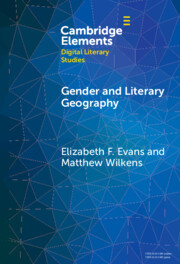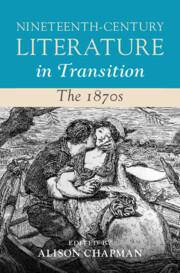Refine search
Actions for selected content:
129 results
Chapter 8 - Competition in the Attention Economy
-
- Book:
- Politicians and Mass Media in the Age of Empire
- Published online:
- 20 September 2025
- Print publication:
- 09 October 2025, pp 298-348
-
- Chapter
- Export citation
LLM agents for interactive exploration of historical cadastre data: framework and application to Venice
-
- Journal:
- Computational Humanities Research / Volume 1 / 2025
- Published online by Cambridge University Press:
- 01 October 2025, e11
-
- Article
-
- You have access
- Open access
- HTML
- Export citation
Mapping Out Juridified Conflicts over Mining: The Legal Cultures of the Subsoil Database
-
- Journal:
- Latin American Research Review ,
- Published online by Cambridge University Press:
- 15 September 2025, pp. 1-16
-
- Article
-
- You have access
- Open access
- HTML
- Export citation
Community-Engaged Podcasting with Hidden Heroes in a Small Town
- Part of
-
- Journal:
- Public Humanities / Volume 1 / 2025
- Published online by Cambridge University Press:
- 03 September 2025, e132
-
- Article
-
- You have access
- Open access
- HTML
- Export citation
Teaching an Introduction to Public Humanities: A Pedagogical Experiment
- Part of
-
- Journal:
- Public Humanities / Volume 1 / 2025
- Published online by Cambridge University Press:
- 11 August 2025, e119
-
- Article
-
- You have access
- Open access
- HTML
- Export citation

Decolonial Deep Mapping
-
- Published online:
- 12 July 2025
- Print publication:
- 14 August 2025
-
- Element
- Export citation
17 - The Holocaust and Digital Humanities
- from Part III - Culture and Ideas
-
-
- Book:
- The Cambridge History of the Holocaust
- Published online:
- 16 May 2025
- Print publication:
- 12 June 2025, pp 398-420
-
- Chapter
- Export citation
Chapter 12 - The History of Mary Prince and Digital Humanities
-
-
- Book:
- The Cambridge Companion to Mary Prince
- Published online:
- 24 April 2025
- Print publication:
- 08 May 2025, pp 201-218
-
- Chapter
- Export citation

Gender and Literary Geography
-
- Published online:
- 21 April 2025
- Print publication:
- 22 May 2025
-
- Element
- Export citation
Chapter 13 - Entre Balas y Rugidos
- from Part IV - Form
-
-
- Book:
- Latinx Literature in Transition, 1848–1992
- Published online:
- 10 April 2025
- Print publication:
- 17 April 2025, pp 227-241
-
- Chapter
- Export citation
The Failure of Form: Reading Liminality Computationally in Dostoevskii’s The Double
-
- Journal:
- Slavic Review / Volume 84 / Issue 1 / Spring 2025
- Published online by Cambridge University Press:
- 21 July 2025, pp. 23-42
- Print publication:
- Spring 2025
-
- Article
-
- You have access
- Open access
- HTML
- Export citation
How To Do Academic Blogging
- Part of
-
- Journal:
- Public Humanities / Volume 1 / 2025
- Published online by Cambridge University Press:
- 26 February 2025, e68
-
- Article
-
- You have access
- Open access
- HTML
- Export citation
How to Lead an Academic Social Network
- Part of
-
- Journal:
- Public Humanities / Volume 1 / 2025
- Published online by Cambridge University Press:
- 19 February 2025, e60
-
- Article
-
- You have access
- Open access
- HTML
- Export citation
Chapter 3 - Assembling the 1870s
-
-
- Book:
- Nineteenth-Century Literature in Transition: The 1870s
- Published online:
- 30 January 2025
- Print publication:
- 06 February 2025, pp 64-84
-
- Chapter
- Export citation
Entrevista: Fuentes Históricas del Perú
-
- Journal:
- Latin American Research Review ,
- Published online by Cambridge University Press:
- 03 February 2025, pp. 1-16
-
- Article
-
- You have access
- Open access
- HTML
- Export citation

Nineteenth-Century Literature in Transition: The 1870s
-
- Published online:
- 30 January 2025
- Print publication:
- 06 February 2025
Chapter 16 - Cultures of Data
-
-
- Book:
- The New Nineteenth-Century American Literary Studies
- Published online:
- 02 January 2025
- Print publication:
- 23 January 2025, pp 233-248
-
- Chapter
- Export citation
Chapter 1 - The Reception of Hume’s Essays in Eighteenth-Century Britain
- from Part I - Reception
-
-
- Book:
- Hume's <i>Essays</i>
- Published online:
- 02 January 2025
- Print publication:
- 09 January 2025, pp 15-35
-
- Chapter
- Export citation
Weaponized Virality: The Harris Campaign’s TikTok Dramaturgy
- Part of
-
- Journal:
- Public Humanities / Volume 1 / 2025
- Published online by Cambridge University Press:
- 07 November 2024, e23
-
- Article
-
- You have access
- Open access
- HTML
- Export citation
7 - Academia and Advocacy
-
- Book:
- Speech and the City
- Published online:
- 23 May 2024
- Print publication:
- 30 May 2024, pp 118-141
-
- Chapter
- Export citation
